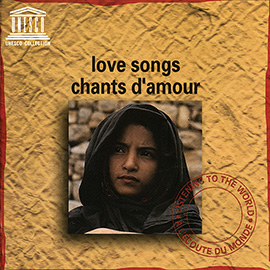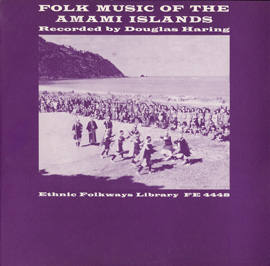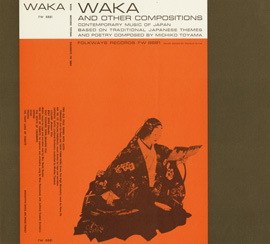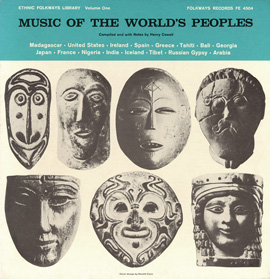Summary
This tutorial provides an introductory view into Japanese traditional ballads or folksongs, known as minyo, and folktales involving the cultural heritage of Japanese mountains. Basic background of Japanese traditional music and Japanese mountain folklore will be discussed; musical activities, experiences, and stories support this lesson.
Suggested Grade Levels: 3-5
Country: Japan
Region: Kyushu Island, border of Saga and Nagasaki prefectures, Honshu Island, border of Kanagawa and Shizuoka prefectures
Culture Group: Samurai, townsfolk
Genre: Minyo, minkan densho (Japanese folklore), Gujo Odori dances
Instruments: Whatever is available in your classroom that can mimic the timbre of traditional Japanese instruments
Language: Japanese
Co-Curricular Areas: History, geography, social studies, language, arts, dance
National Standards: 1, 2, 6, 7, 8, 9
Prerequisites: Familiarity with available instruments in the classroom; basic knowledge of music terminology
Objectives:
- Listen to specific genres of Japanese minyo music
- Distinguish between Japanese taiko, koto, shakuhachi, kawasaki, shinobue, and shamisen instruments
- Aurally identify melody, instruments, soloist, and chorus
- Recreate and perform rhythm, pulse, and dance steps within the musical selection
- Identify Japanese words
- Be able to identify the specific regions of Japan mentioned in the lessons
- Become familiar with Gujo Odori dance
- Become familiar with Japanese folklore
- Understand the cultural importance of mountains in Japanese society
Material:
- Maps of Japan, Mount Tara, Mount Ashigara, Mount Fuji
- Images of taiko drum, koto, shakuhachi, kintaro, samurai, yukata
- Available classroom instruments (specifically drums, drum sticks, flutes, triangle, gong)
- CD player or computer for the teacher
- Space for movement
- Recording of “Shintaro San of the Mountain” (Track 210) on Traditional Folksongs of Japan
Lesson Segments:
- Shintaro San of the Mountain (National Standards 1, 2, 6, 7, 8, 9)
- Japanese Minyo and Japanese Dance (National Standards 1, 2, 6, 8, 9)
- Japanese Mountain Folklore of Kintaro (National Standards 1, 2, 8, 9)
Lesson 1: Shintaro San of the Mountain
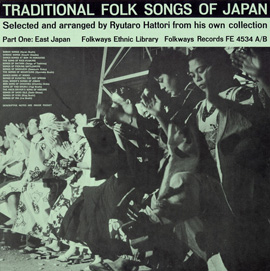
“Shintaro San of the mountain”
from Traditional Folk Songs of Japan (1961) | FW04534
Lesson 1:
- Students will listen attentively to “Shintaro San of the Mountain,” then respond to the following questions (start and stop the recording as needed, or restart for each question):
- Identify instruments: What types of instruments do you hear? How many do you think you hear? (You can help students along with the correct names, but flute and zither are good starting points.)
- Identify the singers: Is there a soloist? Is there a chorus?
- Identify the mood: Is this a happy or a sad song?
- Ask students if they can hear verses in the song. What is its form? (Verse and chorus.)
- Ask students if they can identify certain repeated words within the song. (Shintaro San or yoi, for example; yoi is mostly found in the chorus and often means “good.”)
- Identify and explore the country of origin of this song.
- Show a map of Japan and discuss that Japan is an archipelago.

www.worldatlas.com/webimage/countrys/asia/jp.htm
- Identify Mount Tara on Kyushu Island at the border of Saga and Nagasaki prefectures.

- Let students know that this is the mountain that Shintaro San comes down to visit the village. Tara Mountain is 2,177 feet tall but only the 720th highest mountain in Japan. That means that Japan has a lot of very tall mountains.
- Ask the students if they know of a famous Japanese mountain. The most famous and also the highest is Mount Fuji (known also as Fujiyama or Fuji-san; in Japanese, yama means mountain and san is an alternate translation of the Chinese character).
- Further discuss “Shintaro San of the Mountain.”
- Provide students with background information about this song, using the album’s liner notes.
- Shintaro San was a samurai (highly respected Japanese warrior) who lived in a monastery on Mount Tara.
- He was very well liked by the townsfolk because of his gallantry.
- Have students get up and act out roles as townsfolk and samurai, taking a leisurely walk on the mountain or in the village, greeting each other, meeting up, having conversations, etc. Ask: What would their conversations be about? The catch of the day? Their favorite food or music?
- Play “Shintaro San of the Mountain” again and have the students follow the musical beat while continuing to act as townsfolk and samurai.
- Play and sing to “Shintaro San of the Mountain.”
- Distribute classroom instruments, divide students into groups of instrumentalists and actors/singers, and start the song over again.
- Invite students to play/clap/sing along as soon as the music begins. Singers can use vocables and instrumentalists can play or clap any beat they feel/hear while following the instruments of the recording. Direct attention to the repeated yoi sung by both singers.)
- Switch groups until everyone has had a chance to do every activity.
Assessment:
- Students must be able to sing the main melody of ‘Shintaro San of the Mountain on vocables
- Students must be able to improvise a rhythm that goes with the song, using non-pitched percussion instruments
- Students must be able to move to the beat of the song while playing their percussion instruments or while singing the melody on vocables
Lesson 2: Japanese Minyo and Japanese Dance
- Review “Shintaro San of the Mountain.”
- Have students recall its country of origin, background, and context.
- Recreate performance of “Shintaro San of the Mountain” with groups of actors/singers and instrumentalists.
- Share pictures of Japanese townsfolk, paying attention to the traditional Japanese summer garment, yukata, and the clothing worn by samurai.

Townsfolk at play and singing during a lantern festival wearing yukatas, traditional summer kimono made from cotton

Katsushika Hokusai print depicting a busy town

Actual samurai from the final years of the Edo Period (1853–67) by the name of Shibusawa Heikuro
- Talk about Japanese minyo.
- Share with your students that Japanese minyo encompass all traditional Japanese folksongs. The more traditional name for minyo are inaka bushi and uta (song/singing). The content of these songs relate to everyday work likefishing or specific trades, but can also be performed for pure entertainment. Minyo are said to evoke nostalgia for one’s home, family, and scenery
- Inform your students about Japanese dance festivals like Gujo Odori. which happens every year in the Japanese town of Gujo Hachiman and extends over thirty-one festive nights from mid-July to September. It began over four hundred years ago to promote friendship and familiarity between townsfolk, regardless of social standing.
- Play a recording of the Hachiman Machi minyo “Gujo Odori” from Traditional Folk Dances of Japan.
- Identify instruments: What types of instruments do you hear? (Shinobue flute, drum, shamisen fiddle)
- Identify the singers: Is there a soloist? A chorus? (Chorus/dancers)
- Identify the mood: Is this a happy or a sad song?
- Compare to “Shintaro San of the Mountain.” What are the differences and similarities?
- There are ten Gujo Odori songs, and this one is called “Kawasaki.” It is the most famous of the ten, and its dance moves depict the rivers and mountains that surround the city of Gujo Hachiman.
- Share the lyrics of “Kawasaki” (see appendix).
- Teach the dance steps of “Kawasaki.” The dance is very easy, and the sections repeat over and over; a video tutorial is available here.
- Start by standing sideways and take a step forward with you left leg. Now lift the right leg and tip your toes onto the ground behind you. At the same time, lift your left hand to your eyes as to observe the scenery. Repeat three times walking left, right, left. It should look like a leisurely walk in nature.
- Now turn toward the front with a step of the right leg, following with the left leg until both legs are next to each other, while both arms are stretched out swinging to the right. Now take a step back with the left leg, follow with the right and swing the arms toward the left; end by mimicking a mountain top by putting your fingertips together, above your head.
- Open up your arms to indicate the plains and rivers, while taking a step forward with the left foot. Lift you right leg across the left as if to kick a ball with you knee and clap twice.
- Lastly, repeat the same leg lift across the body to the right (stand on the right leg and lift the left) but only clap once before returning to the beginning of the sequence.
Assessment:
- Students must be able to accurately dance the ‘Kawasaki’ to the “Gujo Odori” song.
Lesson 3: Japanese Mountain Folklore of Kintaro
- Talk about what a cultural treasure is.
- Many Japanese mountains are central to Japanese legends and seen as cultural rather than a natural treasures.
- Share with students that mountains in Japan are interwoven with the cultural heritage, meaning they are connected to the daily lives of the Japanese people and to all Japanese art forms. Mount Fuji, for example, was added to the UNESCO World Heritage List in 2013 because it has “inspired artists and poets and has been the object of pilgrimage for centuries.”
- Find Mount Fuji on the Japanese map (use the map below or the map from Lesson 1).
- Look for Mount Ashigara on Honshu Island, located at the border of Kanagawa and Shizuoka prefectures.

www.mountain-forecast.com/peaks/Mount-Ashigara
- To showcase a mountain legend, talk about the folktale of Kintaro.

- Before introducing the Kintaro legend, discuss some features of Japanese folklore:
- Japanese folklore can be compared to fairytales.
- Every culture around the world has tales about people, places, events, monsters, or heroes, and Japan has them as well.
- Many Japanese tales even start with the well known ”Once upon a time” (mukashi, mukashi).
- Kintaro or “Golden Boy” is a Japanese folk hero stemming from popular folklore. He is often the theme of kabuki and Noh plays.
- Kintaro is supposedly based on a real person by the name of Sakata Kintoki who was said to have grown up on Mount Ashiaga before becoming a retainer for Minamoto no Reiko (Regent of the Fujiwara clan). Sakata Kintoki’s strength and bravery was apparently unmatched.
- Share a shortened version of Kintaro’s legend: Kintaro was born on a lonely mountain because his mother had fled the capital to escape civil unrest. There on Mount Ashiaga, Kintaro developed unbelievable superhuman strength as a young child and was a dear friend to all animals; a bear, a deer, a monkey, and a hare became his constant companions. One day, a woodcutter observed Kintaro creating a bridge for his animal friends by ripping out a very large tree so he could lay it across a river. Amazed by his strength, the woodcutter followed Kintaro back to his dwelling, and there he informed Kintaro and his mother that he was actually General Sadamitsu in the service of the great Lord Minamoto no Reiko. General Sadamitsu asked Kintaro and his mother if Kintaro could join him in the capitol of Kyoto to train and become a samurai. This was a great honor, and they agreed. Kintaro went to the capital, and after he finished his training successfully, he sent for his mother to live with him in Kyoto. Kintaro grew up to be a very famous and revered samurai.
- Ask your students to compare this story to other fairytales they know. What are the similarities and differences?
- Discuss why mountains in Japan are a cultural treasure.
- Have the students come up with their own Japanese-style fairytales inspired by “Shintaro San of the Mountain” and the “Kawasaki” dance. Possible topics include: What friendly mythical beast does Shintaro San encounter on his way to the village? What could be the reason for endless dancing though the night at the Gujo Okogi festival?
- Review both songs and contexts.
- Start with “Shintaro San of the Mountain.”
- Play the music again and divide groups as in the first lesson to perform the song.
- Recall the song’s context.
- Move on to “ Kawasaki.”
- Play the music and have students perform the dance.
- Recall the song’s context.
- Ask students what they would like to learn more about and invite any and all questions that relate to the three lessons.
- Look for a performance opportunity at school so students can share their learning.
Assessment:
- Using the melody of one of the Japanese songs that they learned in this lesson, students must add English lyrics that are based off of a popular fairytale.
- After the lyrics are created, students must create a dance that goes with both the lyrics they created and the sound of the music. Their dance must tell the story of the fairytale they chose to depict.
Lyrics:
When Shintaro San of the mountain
Comes down all the way to town,
Pray light up the road all over,
With thousands of golden lanterns,
For so handsome, so gallant,
Yes, so lovable a man is he!
When Shintaro San of the mountain
Goes back home from town,
Throw water upon and make the road slippery
(So as to detain him by all means),
For so handsome, so gallant,
Yes, so loveable a man is he!
Shintaro San of the mountain
Be likened to the fair and ripened
Persimmons on a tall tree;
Your pole will never reach them,
Climb the tree you never can,
For so handsome, so gallant,
Yes, so loveable a man is he!
Recording of “Gujo Odori” (Track 204) on: Traditional Folk Dances of Japan
Lyrics:
When you leave Hachiman-machi,
You'll leave it with your sleeves all wet
Even when it is not raining.
Moon's wife has eloped,
And he calls her name from above the clouds.
The songs have no end; the dance has no end;
Nor has this moonlight night.


